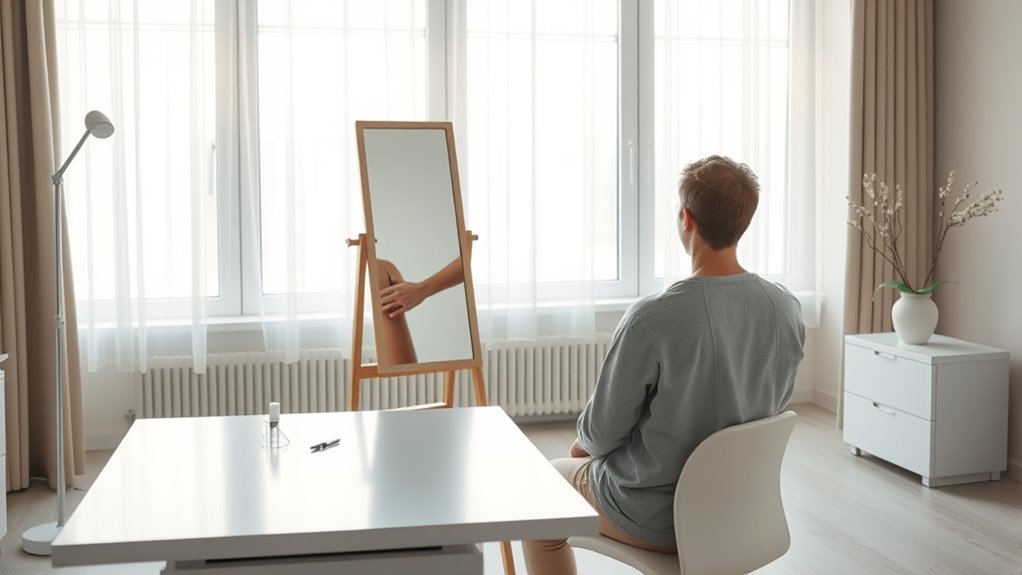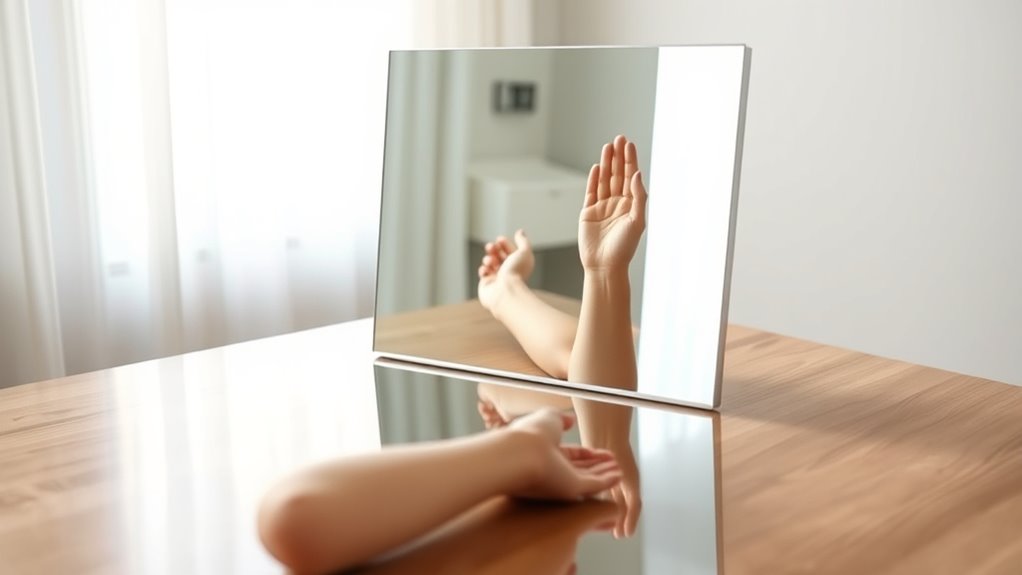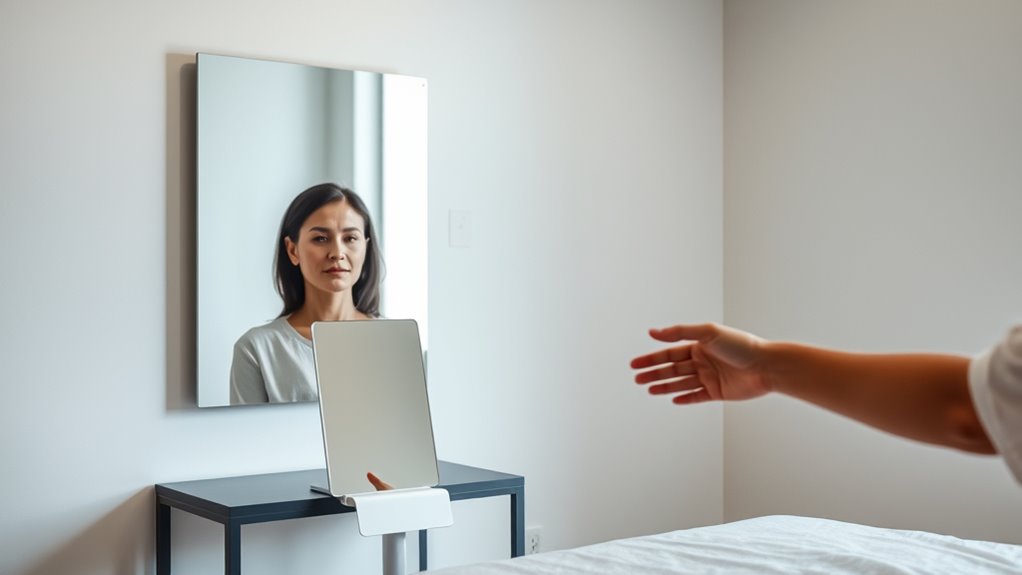Mirror therapy helps reduce phantom behaviors like pain, tingling, or itching by using visual feedback to rewire your brain’s neural pathways. When you position a mirror to reflect your healthy limb, it tricks your brain into perceiving movement or presence where the phantom sensation occurs. With consistent practice, this therapy promotes neuroplasticity, helping lessen these sensations over time. Keep exploring, and you’ll discover more about how this effective technique can support your recovery.
Key Takeaways
- Mirror therapy uses visual feedback to reorganize neural pathways, reducing phantom sensations like pain, tingling, and itching.
- Regular practice of mirror therapy promotes neuroplasticity, helping the brain recalibrate signals associated with phantom behaviors.
- Proper setup involves positioning a mirror to reflect the healthy limb, creating illusions of presence and movement of the phantom limb.
- Evidence shows mirror therapy can significantly decrease phantom pain and distress when incorporated consistently into rehabilitation routines.
- Combining mirror therapy with other treatments and monitoring progress enhances long-term relief of phantom behaviors.
Understanding Phantom Behaviors and Their Impact

Phantom behaviors are involuntary actions or sensations that persist even after the original cause has been addressed, often affecting individuals with amputations or neurological conditions. You may experience sensations like itching, tingling, or even pain, despite the missing limb or affected area. These behaviors can be distressing, making it hard to focus on daily activities. They often result from your brain’s continued neural activity, which misinterprets signals and creates the illusion that the limb is still present. Understanding these behaviors helps you realize they’re not intentional, and they’re a common part of the recovery process. Recognizing their impact allows you to better manage your reactions and explore therapies that can help reduce these persistent sensations. Mirror therapy, techniques such as mirror therapy, have been shown to be effective in addressing phantom behaviors. Additionally, research indicates that engaging in neural plasticity can promote the brain’s ability to adapt and diminish these involuntary sensations.
The Principles Behind Mirror Therapy

Mirror therapy works by harnessing the brain’s remarkable ability to reorganize itself through visual feedback. When you look into a mirror, you see the reflection of your intact limb, which tricks your brain into perceiving movement or presence where there is none. This visual input can help recalibrate neural pathways associated with missing or phantom limbs. The core principle is that your brain responds to visual cues more strongly than to conflicting sensory signals from residual nerves or muscles. By providing this consistent and convincing visual stimulus, mirror therapy promotes neuroplasticity—your brain’s capacity to form new connections. This process helps reduce phantom sensations and behaviors by encouraging your brain to interpret signals differently, ultimately easing discomfort and unwanted perceptions. Neuroplasticity plays a crucial role in this adaptation process. Using the right equipment, such as specialized spray tips, can also improve the effectiveness of physical therapy techniques by ensuring precise and smooth application of therapeutic materials. Additionally, incorporating appropriate visual stimuli can enhance the overall success of mirror therapy in reducing phantom behaviors. Recognizing the importance of brain adaptability highlights why tailored visual cues are essential for successful therapy outcomes.
Implementing Mirror Therapy: Techniques and Practices

To effectively implement mirror therapy, you should start by setting up a simple and comfortable environment where you can focus on the mirror without distractions. Choose a well-lit space with minimal noise, and position a mirror so that you can see the reflection of your intact limb clearly. Sit comfortably, ensuring your eyes are level with the mirror’s surface. Begin by relaxing your body and taking slow, deep breaths. Focus your attention on the reflection, imagining it as your affected limb moving normally. Practice gentle movements with your healthy limb while watching the reflection. Incorporating jet propulsion principles can enhance the fluidity and ease of your movements during therapy. Utilizing visual feedback is essential to reinforce neural pathways and promote recovery. Consistency is key—aim for daily sessions of 15 to 30 minutes. Over time, this practice can help retrain your brain and reduce phantom behaviors, especially when combined with neuroplasticity techniques that support brain adaptation. Incorporating brain reorganization principles can further enhance the effectiveness of your therapy.
Evidence Supporting the Effectiveness of Mirror Therapy

Numerous studies have demonstrated that mirror therapy can markedly reduce phantom limb behaviors and pain. Research shows that patients who use mirror therapy experience significant decreases in phantom sensations, including tingling, cramping, and discomfort. For example, clinical trials reveal that consistent mirror therapy sessions lead to improvements in both pain intensity and the frequency of phantom limb sensations. Neuroimaging studies further support these findings, showing changes in brain activity associated with the therapy. These results suggest that visual feedback from the mirror helps recalibrate abnormal neural circuits responsible for phantom behaviors. Additionally, understanding the neural mechanisms involved provides a foundation for optimizing treatment protocols. For instance, the ability to harness attention during therapy sessions can enhance the effectiveness of the intervention. Moreover, considering individual differences in neural plasticity can help tailor more effective treatment strategies. Recent research emphasizes the importance of neuroplasticity in recovery, indicating that repeated therapy may strengthen adaptive neural pathways. Furthermore, integrating auras and other emotional or energetic factors may offer additional insights into patient responses and outcomes. As a result, many patients report better comfort and function after engaging in mirror therapy, making it a promising, evidence-based approach for managing phantom limb phenomena.
Future Directions and Considerations for Patients

As research continues to support the effectiveness of mirror therapy, you should think about integrating it into your long-term treatment plan. Consistency is key; regular practice can enhance results and help manage phantom behaviors more effectively. Be mindful of any discomfort or frustration, and communicate with your healthcare provider about your progress. Additionally, consider combining mirror therapy with other therapies like physical or psychological interventions for a comprehensive approach. To guide your efforts, review the table below, which highlights important considerations:
| Consideration | Action |
|---|---|
| Frequency of sessions | Practice daily or as recommended by your provider |
| Monitoring progress | Keep a journal of your experiences and symptoms |
| Adjusting techniques | Modify exercises based on comfort and effectiveness |
| Combining therapies | Use alongside other treatments for better outcomes |
| Seeking support | Join support groups or consult professionals regularly |
Mirror therapy is supported by scientific research indicating its potential to influence brainwave patterns and aid in pain management. Regular practice can also help reinforce neural pathways associated with phantom limb sensations. Maintaining consistent effort over time may lead to more significant and lasting improvements.
Frequently Asked Questions
Can Mirror Therapy Completely Eliminate Phantom Limb Sensations?
You wonder if mirror therapy can fully eliminate phantom limb sensations. While it often helps reduce discomfort and improve your quality of life, it might not completely eliminate all sensations. Everyone’s experience varies, and some may see significant relief, while others might notice only partial improvements. Keep in mind, mirror therapy is a helpful tool, but it may need to be combined with other treatments for the best results.
Are There Any Risks or Side Effects Associated With Mirror Therapy?
Be aware of potential pitfalls before proceeding. Mirror therapy might cause mild discomfort, dizziness, or frustration if it doesn’t work immediately. Some people experience eye strain or headaches from prolonged focus. While serious side effects are rare, emotional shifts or phantom sensation intensification can occur. You should communicate with your healthcare provider to minimize risks, ensuring a safe, supportive, and successful therapy session.
How Long Does It Typically Take to See Improvements?
You might wonder how long it takes to notice improvements. Typically, you could start seeing changes within a few sessions, but it often varies based on your condition and consistency. Some people experience relief after just a week, while others might need several weeks of regular therapy. Staying committed and practicing daily can help speed up progress, so keep at it and be patient with your journey.
Is Mirror Therapy Suitable for All Types of Phantom Behaviors?
Imagine trying to fit a key into every lock you find—some fit, others don’t. Similarly, not all phantom behaviors respond to mirror therapy. It’s most effective for phantom limb pain and certain sensations but might not work for all types, especially complex or emotional ones. You should consider your specific experience and consult a professional to determine if this approach fits your needs, as it isn’t a universal solution.
Can Children or Elderly Patients Benefit From Mirror Therapy?
You might wonder if children or elderly patients can benefit from mirror therapy. Yes, they can, as this approach is adaptable across ages. Children often respond well because of their plasticity, and elderly patients may find it helpful for pain management and phantom limb sensations. However, you should consider individual health conditions and cognitive abilities. Consulting healthcare professionals guarantees safe and effective application tailored to each person’s needs.
Conclusion
By embracing mirror therapy, you can take an active step toward reducing phantom behaviors and improving your quality of life. Remember, “A journey of a thousand miles begins with a single step,” so don’t hesitate to explore this promising approach. With patience and consistency, you may find relief and regain control over your experiences, turning hope into reality. Keep an open mind, and let mirror therapy be your guiding light on this path to healing.









